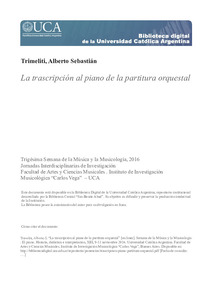Por favor, use este identificador para citar o enlazar este ítem:
https://repositorio.uca.edu.ar/handle/123456789/1283| Título: | La trascripción al piano de la partitura orquestal | Autor: | Trimeliti, Alberto Sebastián | Otros colaboradores: | Jornadas Interdisciplinarias de Investigación : El piano: historia, didáctica e interpretación (13º : 2016 : Buenos Aires) Universidad Católica Argentina. Facultad de Artes y Ciencias Musicales. Instituto de Investigación Musicológica "Carlos Vega" |
Palabras clave: | PIANO; PARTITURAS; MUSICA; ANALISIS MUSICAL; SEMIOTICA | Fecha de publicación: | 2016 | Cita: | Trimeliti, Alberto S. “La trascripción al piano de la partitura orquestal” [en línea]. Semana de la Música y la Musicología : El piano. Historia, didáctica e interpretación, XIII, 9-11 noviembre 2016. Universidad Católica Argentina. Facultad de Artes y Ciencias Musicales; Instituto de Investigación Musicológica “Carlos Vega”, Buenos Aires. Disponible en: https://repositorio.uca.edu.ar/handle/123456789/1283 | Resumen: | Resumen: La problemática nos introducirá a las producciones orquestales planteadas como hipotextos de sus transformaciones acumulativas según las consideraciones semióticas acerca de las transcripciones en tanto caso particular de hipertextualidad. La transcripción encontraría sus inicios en las prácticas madrigalistas del S. XVI y forjaría una tradición específicamente pianística a partir de las aportaciones de J.S. Bach. Sin embargo logra su esplendor con las contribuciones lisztianas en la búsqueda de recursos técnicos y repertorio de exhibición aptos tanto para el aprovechamiento de las posibilidades del instrumento como para gratificar los reclamos estéticos románticos. Comenzado el S.XX la transcripción al piano sigue siendo heredera directa de Liszt y de sus discípulos. Con la aparición de un nuevo objetivismo en las escuelas pianísticas, esta tradición permanece sólo latente y en los últimos años parecería renacer acompañada de la emergencia del nuevo y discutible concepto de super virtuoso (H.C. Schonberg). El nuevo desafío surge en consideración de la potencialidad de la transcripción pianística respecto de las producciones posmodernas y los interrogantes semióticos se inscriben en relación a la identidad de la obra y en consecuencia en la inclusión de ésta o no bajo la categoría de hipertexto. Abstract: The issue will introduce us to the orchestral productions as hypotexts raised their cumulative changes according to current semiotic considerations (López Cano, 2007) about transcriptions as a particular case of hypertext. The transcript find its beginnings in the sixteenth century madrigal practices and forge a specifically pianistic tradition from the contributions of J.S. Bach. However she achieves its splendor with lisztianas contributions in the search for technical resources and repertoire of display suitable for both use of the possibilities of the instrument and to gratify the romantic aesthetic claims. S.XX started piano transcription remains a direct descendant of Liszt and his disciples. With the emergence of a new objectivism in the pianistic schools, this tradition remains latent and only in recent years seem reborn accompanied the emergence of new and controversial concept of super-virtuoso (H. C. Schonberg). The new challenge arises in consideration of the potential of piano transcription respect of post-modern productions and semiotic questions enroll in relation to the identity of the work and therefore the inclusion of this or not under the category of hypertext. |
URI: | https://repositorio.uca.edu.ar/handle/123456789/1283 | ISBN: | 978-987-620-323-4 | Disciplina: | MUSICA | Derechos: | Acceso Abierto | Fuente: | Jornadas Interdisciplinarias de Investigación : El piano: historia, didáctica e interpretación (13º : 2016 : Buenos Aires) |
| Appears in Collections: | JII 2016 13a. |
Files in This Item:
| File | Description | Size | Format | |
|---|---|---|---|---|
| trascripcion-piano-partitura-orquestal.pdf | 1,96 MB | Adobe PDF |  View/Open |
Visualizaciones de página(s)
893
comprobado en 30-abr-2024
Descarga(s)
2.932
comprobado en 30-abr-2024
Google ScholarTM
Ver en Google Scholar
Altmetric
Este ítem está sujeto a una Licencia Creative Commons

